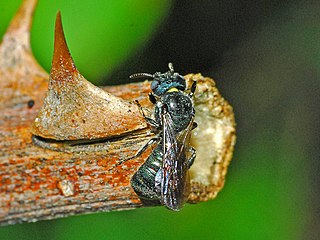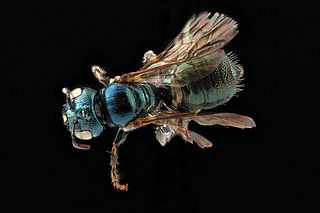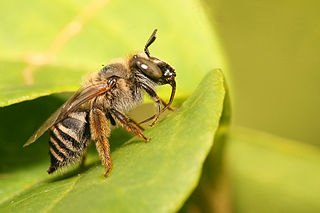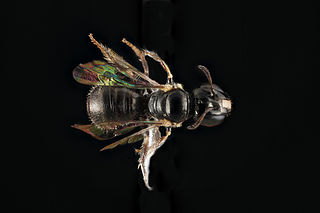
Apidae is the largest family within the superfamily Apoidea, containing at least 5700 species of bees. The family includes some of the most commonly seen bees, including bumblebees and honey bees, but also includes stingless bees, carpenter bees, orchid bees, cuckoo bees, and a number of other less widely known groups. Many are valuable pollinators in natural habitats and for agricultural crops.

The subfamily Xylocopinae occurs worldwide, and includes the large carpenter bees, the small carpenter bees, the allodapine bees, and the relictual genus Manuelia.

The cosmopolitan bee genus Ceratina, often referred to as small carpenter bees, is the sole lineage of the tribe Ceratinini, and is not closely related to the more familiar carpenter bees. The genus presently contains over 300 species in 23 subgenera. They make nests in dead wood, stems, or pith, and while many are solitary, a number are subsocial, with mothers caring for their larvae, and in a few cases where multiple females are found in a single nest, daughters or sisters may form very small, weakly eusocial colonies. One species is unique for having both social and asocial populations, Ceratina australensis, which exhibits all of the pre-adaptations for successful group living. This species is socially polymorphic with both solitary and social nests collected in sympatry. Social colonies in that species consist of two foundresses, one contributing both foraging and reproductive effort and the second which remains at the nest as a passive guard. Cooperative nesting provides no overt reproductive benefits over solitary nesting in this population, although brood survival tends to be greater in social colonies. Maternal longevity, subsociality and bivoltine nesting phenology in this species favour colony formation, while dispersal habits and offspring longevity may inhibit more frequent social nesting in this and other ceratinines.

Ceratina cyanea, common name blue carpenter bee, is a species of bee belonging to the family Apidae, subfamily Xylocopinae.
Ceratina hieroglyphica, is a species of bee belonging to the family Apidae, subfamily Xylocopinae. It makes its nest out of twigs of multiple plant species, including Anacardium occidentale and Caesalpinia pulcherrima.
Ceratina binghami is a species of bee belonging to the family Apidae, subfamily Xylocopinae. It constructs nests in stems of plants such as Caesalpinia pulcherrima and Adenanthera pavonina. Females guard the nest entrance.

Bombus transversalis is a bumblebee specifically native to the Amazon Basin. It is most notable for its surface-level colonies which are built by the workers on the rainforest floor. Unlike its relatives, B. transversalis is able to thrive in a humid climate and fend off a wide range of predators because of its resilient nests. While there is great deal of information pertaining to their nests and foraging abilities, there is much more to be learned about relationships within the colony and life cycle of the bee.

Ceratina strenua, the nimble ceratina, is a species of small carpenter bee in the family Apidae. It is found in North America.

Ceratina cobaltina is a species of small carpenter bee in the family Apidae. It is found in Central America.

Tetraloniella is a genus of long-horned bees in the family Apidae. There are more than 100 described species in Tetraloniella with most being from North America

Ceratina cockerelli is a species of small carpenter bee in the family Apidae. It is found in the Caribbean Sea and North America.
Ceratina nanula is a species of small carpenter bee in the family Apidae. It is found in Central America and North America.

Ceratina arizonensis is a species of small carpenter bee in the family Apidae. It is found in Central America and North America.

Bombus sonorus, commonly known as the Sonoran bumble bee, is a species of bumble bee in the family Apidae. It is found in Central America and western and southwestern North America. Considered uncommon, it is sometimes categorized as a subspecies of Bombus pensylvanicus.

Ceratina calcarata, the spurred ceratina, is a species of small carpenter bee in the family Apidae. It is found in eastern North America. This species ranges from Georgia, USA north to Ontario, Canada and east to Nova Scotia, Canada. This bee is a common generalist, native pollinator, it pollinates plants like watermelon and cucumber very effectively. C. calcarata adds to the productivity of a wide range of ecological and agricultural systems due to its wide range and abundance. This small bee is becoming a model organism in the scientific research of social evolution. C. calcarata is the first subsocial bee species to have its genome published, allowing researchers to investigate the evolutionary origins of social behaviour.
Ceratina sequoiae is a species of small carpenter bee in the family Apidae. It is found in North America. It is a specialist on Clarkia flowers.
Ceratina dallatorreana is a species of small carpenter bee in the family Apidae. It is found in Africa, Europe and Northern Asia, and North America.

Anthophora abrupta is a species of anthophorine bee in the family Apidae. It is found in North America. Females only mate once, while males can mate multiple times. This bee nests gregariously - when one female starts building a nest, others are attracted by her movements and pheromones.

Ceratina dupla, the doubled ceratina, is a species of small carpenter bee in the family Apidae. It is found in the eastern half of North America. It was formerly confused with the species Ceratina floridana and Ceratina mikmaqi, until molecular analyses demonstrated significant genetic differences between the taxa.

Pemphredon lethifer is a Palearctic species of solitary wasp. It prefers to make nests using large twigs from the genus Sambucus.















